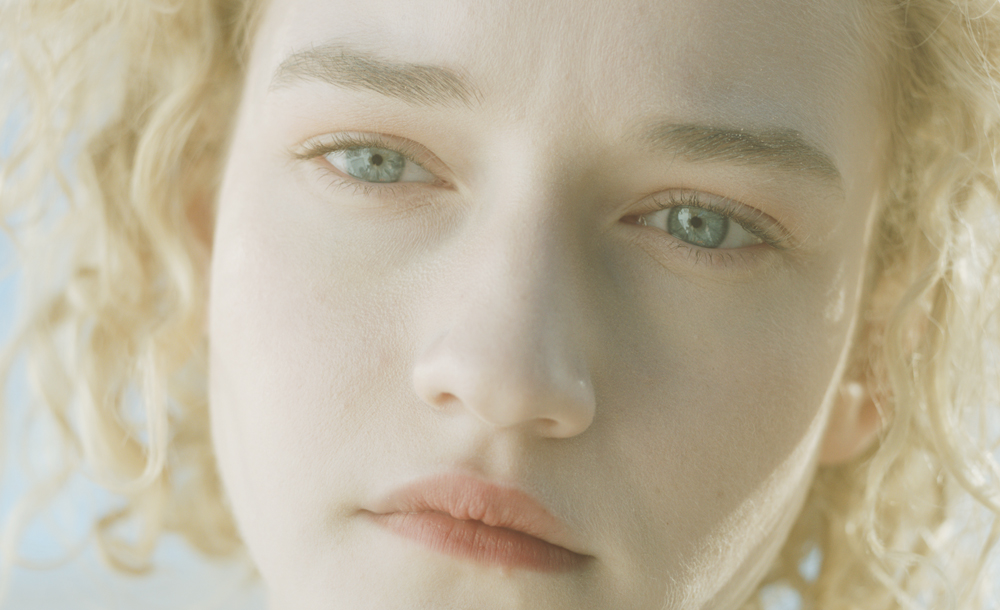You don’t know where you are or when exactly you meet Lernert (Joseph Cross) and Rola (Julia Garner), two survivors of the apocalypse who have just crossed paths themselves, at the start of Pete Ohs and Andrea Sisson’s “Everything Beautiful is Far Away,” but you’ll be able to instantly identify with them as they traverse sand dunes in search of a mythical Crystal Lake where they can wet their beaks. Ohs and Sisson’s narrative debut, following their 2013 documentary “I Send You This Place,” may find its two leads sweating out the sun that bears down upon them — as well as forging a trusting relationship, which doesn’t come easy since the two are diametrically opposed in how they see their predicament, with the sensible Lernert operating out of fear of the unknown while Rola embraces it with her curiosity and insatiable wonder. But the film feels as if it were an oasis in the middle of the desert itself, observing the two carry along the still-functional head of a circumspect robot named Susan (voiced by Jillian Mayer, when it has enough battery power to operate) and considering their place on this earth, and the filmmakers’ constant inventiveness whisps through the air like a cool breeze that comes with approaching the water.
Although Ohs and Sisson shrewdly planned for a small-scale shoot, building in such details as Lernert’s refusal to walk at night to avoid shooting in the evening when the film would need to use lights, this isn’t to say the two aren’t ambitious. Spending the past three years poring over every detail of a world where sustenance depends on picking the proper root vegetables and the detritus of prior civilization sends the mind reeling with possibility, Sisson scoured eBay in search of handmade tools, and fashioned the head of Susan out of wood milled in Cincinnati and eyes found online that could be manipulated from the back, as Ohs traded music with Neon Indian frontman Alan Palomo to find the perfect emotional pitch for Lernert and Rola’s adventure, eventually leading to themes not only for the individual characters but their specific actions. Even after that was done, the filmmakers would have to hop onto ATVs to get to their location in the remote Glamis Dunes of California, where they could expect 30° mornings and 99° afternoons, following an hour-and-a-half trek out of the nearest city. Yet as arduous a journey as it was to get “Everything Beautiful is Far Away” to the screen, the end result is as rewarding for audiences as one senses it was for the filmmakers, who took home a prize recently for Best Cinematography at the L.A. Film Festival (shared by Ohs and Christian Sorensen Hansen).
Following the film’s recent premiere in Los Angeles, Ohs and producer Saul Germaine, both still in town after Sisson had to leave for school, spoke about carving out the time and space to create such a unique cinematic experience, as well as how Germaine was lured into operating Susan on set and how often happenstance helped the casting process.
How did this come about?
Pete Ohs: I’ve been making videos since I was in junior high school and for some reason had this idea in my head that this is what I should be doing. Eventually, I got teamed up with Andrea and we made a documentary about four years ago in Iceland, and the next idea was let’s make a narrative feature film, which I wrote. The documentary that we made in a lot of ways is very much Andrea’s first film, so that was personal to her and her story and then this one was very personal to me, it was very much my story. We started figuring out how to make it and that’s when Saul came along and said, “I want to make this with you guys.”
Saul, what did you see in this that made you think it could be special?
Saul Germaine: I think largely the singularity of the idea, the heart in the script, the humanity of the characters and this notion that we were making a world that did not exist – that was in another place at an undefined time. That really stood out to me and Pete and Andrea, in general, were just being really visionary in their creative approach, so that paired with the concept unto itself was a winning combo and we dove in to the deep end together.
Pete Ohs: I’m a kid from Ohio [from] a really normal, middle class family, so the idea of making a movie is so foreign – the movie cost more than our parents’ house. So the years spent trying to get it made and connecting with all these people and building this thing up really felt like building something out of nothing. And it’s no wonder that it took all this time to make, because it’s not even that it evolved over time. It’s like my mind was expanding as we were going through this whole process because when you’re just this kid in Ohio watching movies and thinking you’re going to make a movie someday, you don’t even really know what that means.
I had one idea that I thought was going to be the movie and I actually had no idea what I was doing. [laughs] So it got to follow this really beautiful, organic path to creation where each step of the way was learning, processing and challenging. That’s the way I want my life to be because it’s so boring if things are easy all the time.
Was the story pretty much the same from the start or did the themes deepen over time?
Pete Ohs: Yeah, the story was very much there from the beginning. It’s quite personal to me, but because I wrote the script at the end of 2012, it was very much reflecting on who I was and things I had been realizing about myself. I very much was Lernert at that time, and then over time, even though I’ve changed, the script really hasn’t, so when I watch or think about the movie, I really see myself – this straight white guy from the Midwest trying to figure out his own inner turmoil.
How did you find your lead actors for this?
Pete Ohs: Andrea and I were included in Filmmaker Magazine‘s 25 New Faces of Independent Film list in 2013 and for whatever reason, Andrea had been scrolling through previous years of that list and she literally just saw a picture of Julia [Garner] and thought, “Oh, this is Rola.” So we went about trying to track her down through all the various friends and people we’ve ever known. We were able to get the script to her manager and her agent and they liked the script, so they passed it along to her. Then we went to New York and met up with her at the Jane Hotel for coffee, and she said, “I really like your script. I would love to do your movie.” And we said, “That’s great. That was easy.” I don’t think it’s always going to be that easy, but it was nice how serendipitously that fell into place.
Saul Germaine: And Joseph was a bit of an angel who descended upon us. We originally had an actor lined up and for a multitude of reasons, it was meant to be Joe.
Pete Ohs: Joe and Julia share an agent and she was able to really quickly connect us with Joe. We had a really great Skype conversation with him and got him on a plane a week out from shooting. I could not be more grateful for what he brought and how enthusiastically he dove into it. It was the first time he’s done a voice for a character actually.
At the premiere, you mentioned an hour-and-a-half drive to the location. Did that become bonding time for you and the actors?
Pete Ohs: Yeah, a really cool thing about how we made it was [that it was] really intense and this movie is supposed to [be like] going to another place, another dimension almost, so that ridiculously long commute where you would leave when it was dark, both ways [in the morning and at night], I feel had some sort of effect on the psyche of everyone on the whole crew, not just the performers.
Did you have this particular patch of desert in mind from the start?
Pete Ohs: I did have a very specific idea of these dunes in my head, which is the Sleeping Bear Dunes in Michigan. I actually thought I was going to shoot the movie there, but it turns out you’re not allowed to shoot there because it’s government protected land. So I became very well-versed in the sand dunes of the world. [laughs] Many, many Google searches and phone calls and there are sand dunes in Colorado and there are sand dunes in New Mexico.
Saul Germaine: We were talking about doing the film at a few different budget tiers and the one we ended up deciding to work within, at least from the SAG perspective, was shooting in the U.S., so rather than looking in Mexico or North Africa or any of these places where we might find some expansive dunes, we were purposefully drawing a line to limit ourselves to the U.S. and this desert seemed to make the most sense because it was the wildest and most expansive. It’s Bureau of Land Management Land, we could permit a huge patch of the park and do our thing as we liked.
Pete Ohs: There are a handful of sand dunes in Southern California and some of them you can scout, some of them you can just call and get information about. We’d get there [to some locations] and we’d seen all these pictures that people had taken and they’d just look amazing and then you’d go there and you realized they took the picture that you can take. It isn’t like 360 degrees of amazing-looking dunes. There’s just one spot that if you’d stand there straight ahead, you will see these expansive dunes, but if you panned a little bit to the left or to the right, all of a sudden, the illusion’s gone. But the Imperial Sand Dunes, which are southeast California, feel so out of place when you’re driving out to it – on the horizon you see a sliver of pinkish white and as you get closer, you realize out of nowhere it’s this 50-mile stretch of sand dunes, and it very much became the other world that we wanted to film in.
Nothing about this film or the way we shot it was fake. We had to drive out an extra mile away from our initial base camp to shoot these scenes, [because otherwise] you’d turn the camera around 360 degrees, and it would be a bunch of trailers behind us, so at any moment, we are all out there in the middle of nowhere – and it would look [that way onscreen] and I feel like that not only translates to the film, but to the experience we had making it where it just really felt like something specific, something unique, and definitely not something we’re doing every day.
What was it like working with Andrea on this?
Pete Ohs: Working with Andrea is just a magical experience because she has this piercing arrow of truth in all aspects. When she did all the production design for [the film], there’s just something magical about how she does it and you can’t put your finger on it. It’s hard to bring things out of your head into the real world and that’s what I was always impressed by as she was doing it was these imaginary things that we’d talk about now are real. We can really hold them in our hands. When she says, this is what [Lernert’s] going to be wearing, you see it and that’s really what he would be wearing, even though it’s completely made up. It’s what creative geniuses do, and I just feel grateful that she brought all that creative vision to the film because they don’t feel like movie props. They just feel like real things.
Speaking of which, she designed Susan. How did Jillian Mayer come on to give her a voice?
Pete Ohs: When we were on set shooting it, Saul was Susan most of the time, not by choice. [laughs] It was always fun and funny, but we always knew in our heads that someone cool should be the voice, like this is an opportunity to plug in another person to bring in one more level of something to the film. We took our time with it and like all things with this film, there’s a natural way in which things fell into place. I was thinking about who should be Susan and a friend posted on Facebook a video of [Jillian’s]. She’s an artist and a filmmaker I’d definitely been aware of for a while who just does cool work, and the Borscht Corp [which she helps to run] is something I’d been a fan of. I watched [the video] and thought, “She has a really cool voice.” Then I realized that Alan [Palomo] of Neon Indian had just DJ’d at the Borscht Film Festival and I thought, “Oh my God, Alan probably knows Jillian.” So I reached out to Alan and he thought that was a great idea and he sent an e-mail to Jillian, and she actually knows Julia [Garner], which we didn’t realize, so she was super excited to do the project. She just happened to be coming to L.A. the next day, so from the moment we reached out to her, it all circled back around and within 72 hours, we had recorded Susan.
Saul, what was it like operating Susan on the set? That seems like a lot of responsibility on top of what you were doing as a producer.
Saul Germaine: There really weren’t very many of us out there, and [because] I had been closer to the script with Pete and Andrea than any other crew, it was a natural thing. We could follow the flow of a scene and the themes of the story that were being expressed. I always knew I would be replaced and I was fine with that. [laughs] I didn’t actually want to be her forever. It was temporary.
Pete Ohs: Yeah, but he rolled her eyes and did the voice. I don’t know how much Saul was even aware of it, but really how he performed, they were acting with him, so even hearing it with Jillian now, a lot of the performance, [Saul] was in it. [His] soul was in that robot’s head. [laughs]
Saul Germaine: She’s at my house actually. She’s looking at me across the room while we’re talking.
Was this challenging to edit?
Pete Ohs: We naturally found the film, but we did take a lot of time to do it. We spent at least a year editing, which is uncommon for a lot of independent films, but I think a lot more films should spend more time editing. If we had to rush it, I don’t think you would’ve been able to feel the space and the nuance that now is in the film and by having the time to find it and to use temp music — to get Alan’s music and to re-edit and then for Alan to be able to respond to that and either change the music or move it around, allowed it to be very natural. We spend all this time writing these scripts and work so hard to shoot it in as few days as possible and then once we get it done, we push the kid out the door before it can even fly? I want the editing part of the process to be given space because it’s crucial.
Saul Germaine: [In general] the process associated with the making of this movie is unlike any other film project that I’ve worked on and probably will be different than any other film project I will work on. I feel like we have been playing by our own set of rules that has even extended to just a level of understanding being required by the investment base and the people that put in the resources for the film, [with] everyone involved understanding that we were allowing it to breathe and to find itself and not rushing it. That was a gift for all the reasons and it was challenging, but the film is far better for that.
What was the premiere like for you?
Pete Ohs: I don’t ever want to watch a movie with an audience again. [laughs] The same thing happened when we made our documentary four years ago and I forgot the nervousness in my stomach that becomes this full-body torture during the premiere. So the actual watching of it was rough, but the Q & A was super fun and I’m just happy that we made it here because it has been challenging to continually listen to yourself, not get confused by all the things people are saying to you, and to find the right path for you. I’m so honored [specifically] that we won the cinematography award because [the film] is so visual, and the cinematography is so good because the production design is so good, the hair and makeup was done so well and the way the film got produced, [which] put us in that location every day allowed the cinematography to be as special as it is. It’s not just that somebody knew how to use the camera well, but the film got made in a particular way that allowed those images to get created.
Saul Germaine: For sure. It’s a testament to the whole of what we created, the vision that Andrea and Pete had and the way that was actualized physically. Like Pete said, that’s more than just the camerawork. It’s the whole of it, and we were so honored and hopefully it will be a good ticket for us to take the film out into the world further so more people can see it.
“Everything Beautiful is Far Away” does not yet have U.S. distribution.




